Image credits: © Rosetta Stone UK Ltd.
Rosetta Stone – in the field of language learning, the name represents the absolute top tier. But do the language courses live up to their promises? Our Rosetta Stone review provides the answer.
Table of Contents
Overview: Rosetta Stone Review
Advantages
- Excellent learning method
- No tedious grammar or vocabulary cramming
- Very comprehensive: Language course, learning games, short stories, etc.
- Easy use of online lessons in the virtual classroom
Disadvantages
- Higher (but absolutely justified) price
- Relatively little cultural information about the country and its people
- Learning method requires trust and acclimatization
Quick Summary: A Learning Suite in a Class of Its Own
I tested Rosetta Stone for over 3 months, and the premium provider among language courses has excellently mastered talkREAL’s testing procedure. With the learning method called “Dynamic Immersion,” one can learn a language like their native tongue, according to Rosetta Stone. My Rosetta Stone experience confirms this, not least because it completely dispenses with grammar and vocabulary learning in the classic sense. However, one must be open to the somewhat different learning method.
Furthermore, they offer a complete learning suite, the scope of which far exceeds the usual language courses of competitors. Thus, live lessons in the virtual classroom are also (optionally) included.
Additionally, Rosetta Stone offers a very long money-back guarantee, so you can test it yourself without any risk. Which I can only recommend to anyone who is serious about language learning. All details will now follow in the detailed review, and more information, e.g., about cancellation, can be found in our comprehensive Rosetta Stone Guide.
🡳 Rosetta Stone In-Depth Review 🡳
We have been testing Rosetta Stone repeatedly for years. As early as 2014, it secured the top spot in the categories “Best Learning Method” and “Best Language Course.” Why?
Rosetta Stone is much more than just a language course. It’s an entire learning environment that impresses. But let’s begin this review with a look at what exactly was tested.

Rosetta Stone Experiences: What Was Tested?
This review and experience report refers to the more comprehensive online access. In addition to the interactive software, the virtual classroom, the additional learning content Play, Talk, and Read (formerly: Rosetta World), and the mobile app for smartphones were also tested.
To verify the quality and success of Rosetta Stone, I learned Spanish with Rosetta Stone for 5 weeks in a self-experiment. This allowed me to best observe the actual effect of the learning method itself, the so-called “Dynamic Immersion” method.
It is, of course, somewhat more difficult when the alphabet of a language is completely unknown. That’s why I also tried out the Hebrew and Russian courses to get a feel for what it’s like to learn a completely foreign language using the Dynamic Immersion method. And to be able to meaningfully test the later chapters, I chose the English course. A comprehensive insight is thus guaranteed.
Scope and Features: Rosetta Stone is More Than Just a Language Course
When you usually download a language learning app, it’s typically a more or less linear language course. Not so with Rosetta Stone. However, there is a downside here too. But let’s start with the available languages.
Languages You Can Learn with Rosetta Stone
In total, you can learn 24 different languages with Rosetta Stone, which are listed in the image below:
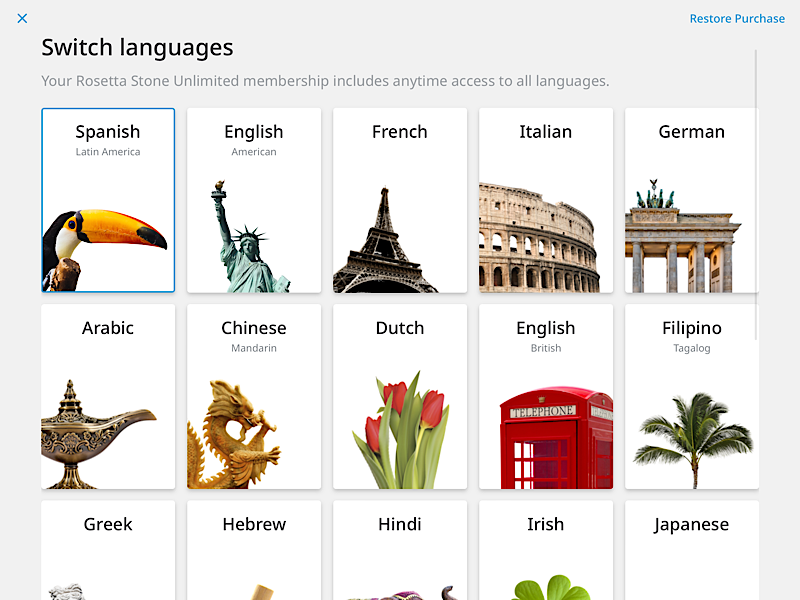
There’s more than the languages shown here – you can also study Korean, Persian, Polish, Portugese (Brasilian), Russian, Spanish (from Spain or from Latin America), Swedish, Turkish and Vietnamese.
Download vs. Online Access
Would you like to learn offline? Do you want to use the program with multiple people? Then the download version might be interesting for you. You can install and use the program on your PC. At least, this was possible in the past. Such software is now mostly found only on the secondary market, and caution is particularly advised regarding licensing.

‒ Black Friday: Language Special ‒
Saving money never hurt anyone, right?
Find the best discounts and exclusive coupons for top
language courses here!
+ + + Limited-Time Deals +++ Some Offers Expiring Soon +++ Don’t Miss Out! + + +
Meanwhile, the download or online version has also become prevalent with Rosetta Stone. This is quite positive, as online access has always included many additional functions. And here too, you can learn offline very well, as you can download the content within the apps and then learn even without an internet connection.
The Learning Suite in Detail
While we previously praised the scope of the learning suite highly, a renewed look into the software brings some disillusionment. In the past months since our last review, Rosetta Stone seems to have quietly removed some features. The learning games and the community are unfortunately no longer to be found.
However, there’s a new design, and everything is a bit clearer. And the most important features have remained with Rosetta Stone. Besides the actual language course, found under the “Learn” tab, there is also “Extended Learning.” Here, you can download the Audio Companion, which is excellent for our SleepHACK, and choose “Stories.” The latter can be read, listened to, and read aloud by yourself, which is then recorded.

‒ The Best Language Course of 2025 ‒
We’ve tested dozens of language courses…
But only ONE takes the #1 spot!
The offering is rounded off by lessons in the virtual classroom, which has been optional since 2020. When choosing the package you buy, you decide whether you want to use these lessons (Live Tutor) or not.
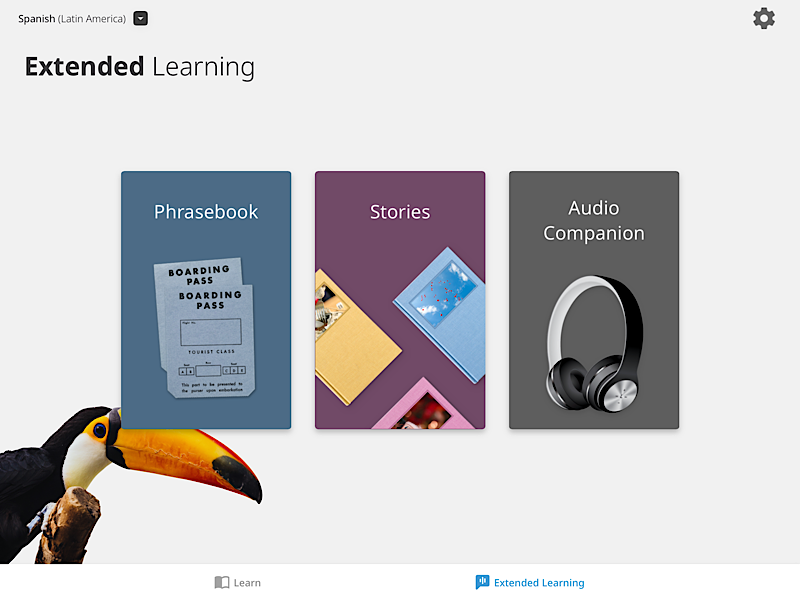
A great development is the new learning path. Here you can choose your starting level and set your personal learning goals. Whether you’re learning for an upcoming trip or for your job, the language course adapts its content accordingly, very good!
Didactics – How Good is the Dynamic Immersion Method?
I’d like to start with the heart of Rosetta Stone, the much-advertised “Dynamic Immersion” method, which promises an immersion into the foreign language as if one were in the respective country. And this doesn’t seem to be just an advertising promise.
No Grammar Rules – No Vocabulary Cramming: This is How the Dynamic Immersion Method Works
Those who have been following the talkREAL Institute for a while know that we are against the tedious cramming of grammar rules and vocabulary lists. It’s not for nothing that we developed our transREAL learning method, which also dispenses with vocabulary and grammar. (You can get an insight into our course here.) The reason for this is simple: such “learning” is simply not brain-friendly. Nevertheless, many language courses are based on these “classic” teaching methods. Not so Rosetta Stone!
The Dynamic Immersion method takes a completely different approach by working exclusively with images and descriptive words and sentences. The goal is to imitate the learning of our native language. Although the video below is a promotional video from Rosetta Stone, it describes very well how the learning method works:
Pictures, Pictures, Pictures – Examples of the Dynamic Immersion Method
It is this indeed ingenious use of images that defines the method, and this is precisely where Rosetta Stone knows how to impress. I have yet to see a language learning program that uses images for learning as well as Rosetta Stone does! The expressiveness is excellent. Because here, it’s not just any photos from stock image portals being used; rather, the images are specially produced for Rosetta Stone and optimized exactly for the word to be described.
In addition, they manage to quickly resolve any ambiguities by combining different images for the same term. Because a picture showing a running boy can stand for “run” just as much as for “boy.” Let’s look at another example.
Shortly before the exercise below, we learned the words for boy and girl and are now being familiarized with the most important verbs/activities:
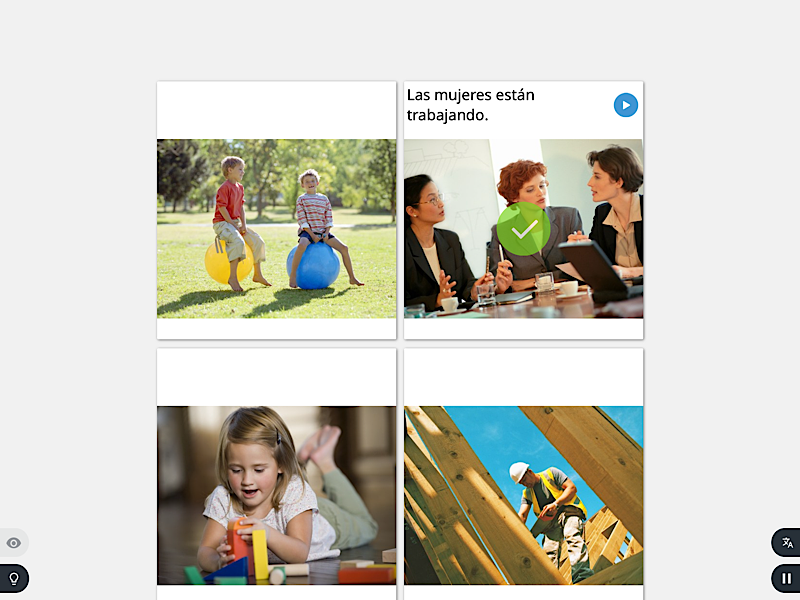
If we now know that “girl” means “Mädchen” (girl), then it’s clear that “drinking” must describe the activity shown. It is subsequently easy to associate the sentence “The boy is drinking.” with the correct image. In doing so, one learns the new word for “drink” and incidentally reinforces the already learned word for “boy.”
After subsequently learning the vocabulary for man and woman with pictures, the next step is to link the content by assigning the corresponding activities to the images of the adults. All content is also always read aloud. Depending on the exercise, one must associate what is heard, repeat it, or type it in oneself.
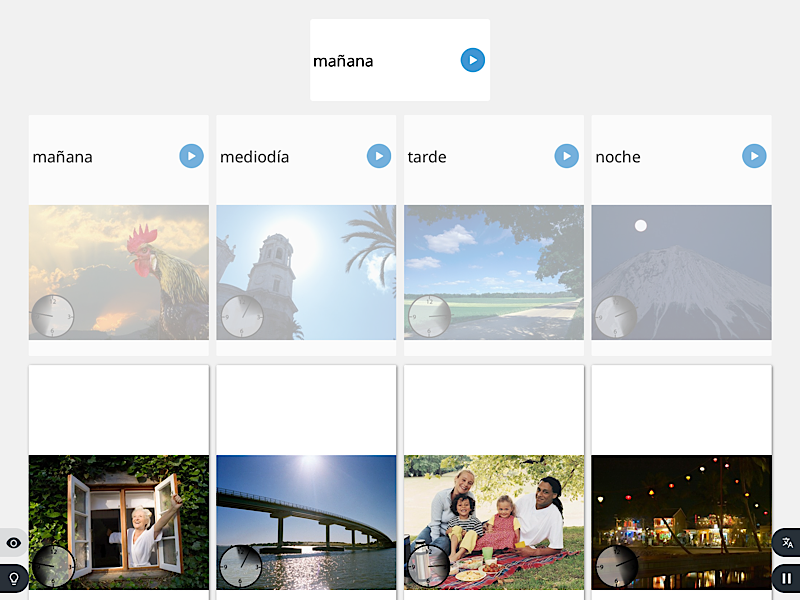
In this way, starting with individual words, one learns to speak entire sentences over the course of the program. The new learning units are very well coordinated and build wonderfully upon each other.
Critique of the Dynamic Immersion Method
A frequently raised point of criticism is that Rosetta Stone is not completely localized. So, you don’t just learn French with French-looking people in front of the Eiffel Tower. This is true. The images seen here are also found in the Russian course and all other languages. If this bothers you, you won’t be happy with Rosetta Stone.
Another common criticism is that progress is made very slowly and the course is rather tedious. Here, the answer is a clear “yes and no.” Indeed, the first exercises in a language we might have even learned years ago are quite simple. If I have to click through countless exercises in Spanish where I only have to match simple syllables, then this is easy and quickly becomes boring. However, if you do the same exercise in Hebrew or Russian, for example, i.e., a language that is completely foreign to you and uses a different alphabet, then this exercise immediately becomes challenging.

‒ Black Friday: Language Special ‒
Saving money never hurt anyone, right?
Find the best discounts and exclusive coupons for top
language courses here!
+ + + Limited-Time Deals +++ Some Offers Expiring Soon +++ Don’t Miss Out! + + +
So, it’s important to remember that Rosetta Stone teaches you a language from the very beginning. If you already have prior knowledge, some exercises, especially at the start, might seem tedious. Here, the new feature of choosing your own learning plan is recommended, as you can also set your own level, which will then be taken into account in the subsequent exercises.
No Trace of English – Immersion in the Foreign Language
Is it a disadvantage or an advantage that you can never display an English translation?! This poses a significant challenge, especially at the beginning when a language (and possibly script) is completely foreign. I’ve caught myself more than once thinking, “Hmm, is this go, walk, or run?” A translation would certainly be very helpful in this context. BUT, as it seems, one understands the different words in their correct context over time.
I am aware that this sounds a bit vague now. But I definitely have the feeling that after a few days and weeks, and constant repetition with different images and groups of people, it eventually becomes subconsciously clear what the right word for “run” is and which one stands for “go”!
Those familiar with our Language Learning HACKS know that we like to point out that we language learners need to learn to deal with uncertainty. Rosetta Stone is a good example of this. Simply engaging with the learning method is important, even if you feel unsure when first using the learned words. But this gets better, and the Dynamic Immersion method is, in my opinion, much more intensive and brain-friendly than the vocabulary cramming offered in other language courses.
If you want to speed up the above-described process of subconscious learning a bit, you can, of course, always look up new vocabulary in a dictionary in parallel. However, note that Rosetta Stone’s stated goal is to think in the foreign language. So, don’t cling too much to your native language. It is more sensible to download the Audio Companion and combine it with our SleepHACK!
Learn Grammar Without Learning Grammar!
As already indicated, Rosetta Stone does not offer grammar explanations as known from traditional language teaching. This sometimes makes it feel more difficult, as we are conditioned to learn a rule. And indeed, I caught myself wondering, what is the rule now, why is this written with a “u” at the end and not with an “a”?
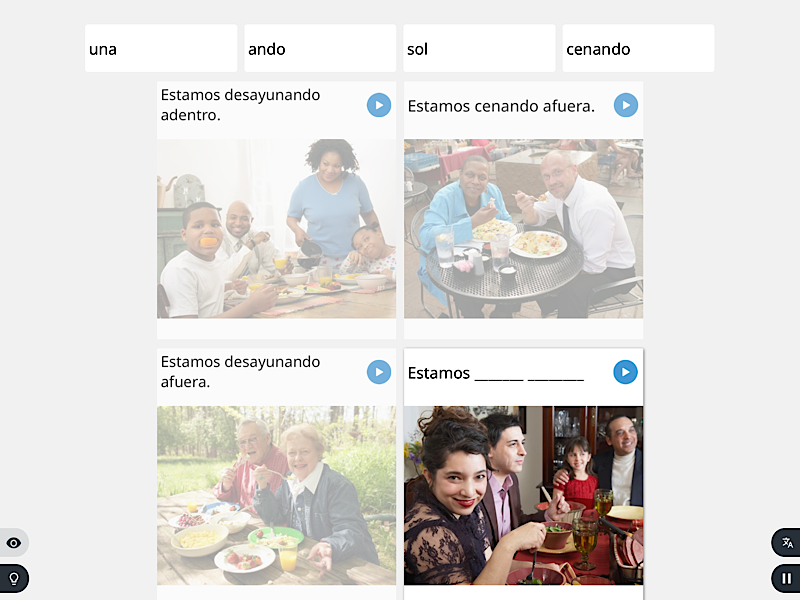
But the “aha!” moment was not long in coming. Already in the second lesson, I automatically chose the correct form in a complete sentence. So, I still can’t explain any rule, but my brain seems to have already subconsciously derived it and intuitively knows what is right. Perfect!
When I say that you don’t have to learn grammar rules, it doesn’t mean that there are no illustrated exercises on grammar questions (see image above). But here too, Rosetta Stone is different and knows how to support our brain in deriving the rules through clever color coding.
Conclusion on the Dynamic Immersion Method: Brain-Friendly Language Learning!
In my opinion, it is important to engage with Rosetta Stone and free oneself from traditional learning methods. Rosetta Stone works differently, and it works very well. It is much more than just mindlessly clicking on pictures. To make correct entries, you have to look very closely and also think a lot. The rest then seems to come almost by itself – just like our native language once did.
In my opinion, the best thing about the Immersion method is the many small successes. Because here, you are not punished for incorrectly applying some grammar rule; rather, you try to personally figure out the solution by weighing the different texts and images.
talkREAL Tip! Here is further information on the topics: Reasons AGAINST vocabulary learning and Language Teaching – It’s time to learn differently!
So, it’s more like a journey of discovery, where you are rewarded for each discovery with a pleasant feeling of happiness. This may sound a bit over the top, but in the end, it’s exactly this effect that we also always use in our Language Learning HACKS to keep motivation high in the long term.
This is also necessary because, as my Rosetta Stone experience shows, the program has few motivating elements integrated otherwise. You have to bring a good deal of self-motivation to stay on track in the long run.
Rosetta Stone Experience with “Extended Learning Content”
Rosetta Stone is more than just a language course, and this is particularly evident when you look at the extended learning content. However, this is also where the most changes have occurred in recent years. Previously, the area called Rosetta World gathered the following functions:
- Play: Mini-games, without direct communication with others
- Talk: Games that require direct communication with other learners
- Read: Reading, listening to, and repeating stories
Unfortunately, the Play and Talk sections are now nowhere to be found. This is a great pity, as here one could find simple games, like a language learning-optimized Memory, which could be played alone or against a partner, up to challenging games like Identi.
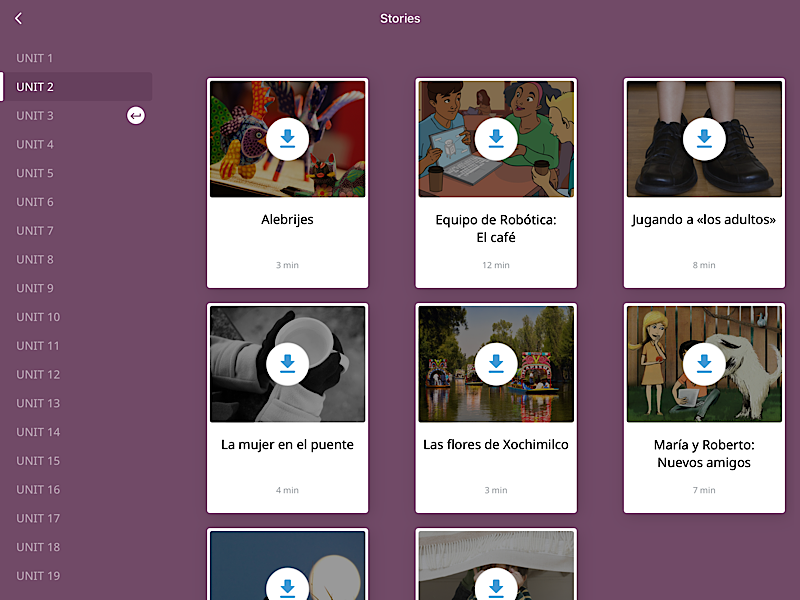
Why these areas, including the function of connecting with other learners, were removed remains Rosetta Stone’s secret. I could imagine that moderation tasks arose here, which are simply very expensive. And if you look at the prices they are now charging, they have steadily decreased in recent years. Perhaps that’s why they are focusing on the core learning tasks.
Admittedly, even in the past, the “Stories” section was the most important. It offers the opportunity to have various texts read aloud. So, you can read the foreign language text and listen at the same time. Additionally, the current progress is displayed, which is enormously helpful, especially with completely foreign languages using non-Latin alphabets.
If you wish, you can then also read the story yourself, with your own pronunciation being checked. Very cool – the program recognizes what you are currently reading aloud and highlights it accordingly. What’s somewhat annoying, however, is that the text cannot be selected with the mouse and therefore unfortunately cannot be copied. A pity, because this would be a perfect template for our transREAL method, which, as is known, also comes without vocabulary and grammar learning! (More on this in our coaching portal)
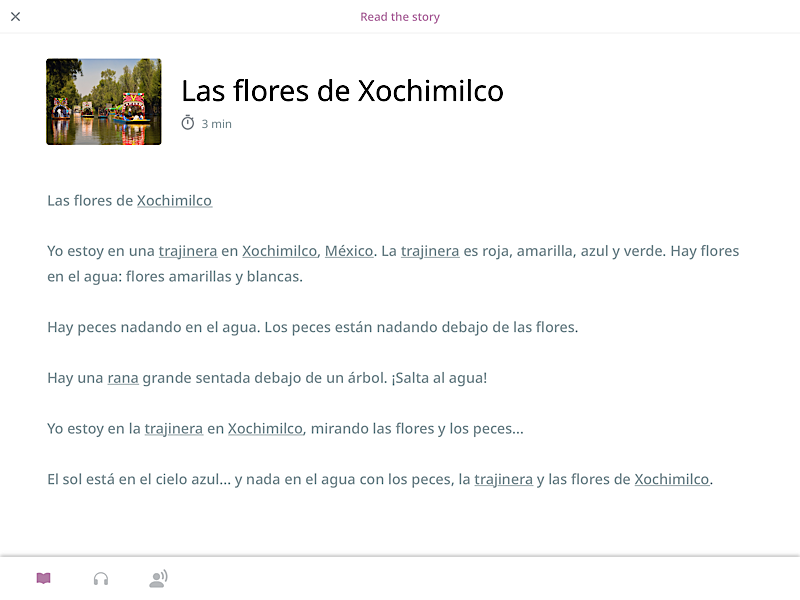
Also New: Advanced words that go beyond the current learning level are provided with images. Simply click on them, and the translation appears in picture form.
I can warmly recommend the Read/Listen function, especially to beginners, as it can be enormously helpful in building up the language center in our brain, because audio material is otherwise a bit too scarce in Rosetta Stone, in my opinion, although all exercises are fully voiced and can also be listened to additionally in the Audio Companion.
User-Friendliness – How Easy is Rosetta Stone to Use?
What good is the best learning method if it can’t be used properly? This brings us to the question of how the actual software-based language course functions.
The Start Screen – Simple and Clear
While the former start screen could be categorized as “colorful and fun,” Rosetta Stone has done well to improve the design. The redesigned command center appears tidy and is easy to operate.
From the start screen shown here, which serves as a command center, you have everything under control:
- Start an exercise of your course
- Schedule your online live lessons
- Access to extended learning content
- Settings, including the person/voice that reads out the sentences
- Various fine tuning for technial adjustments
There is no real introduction in the sense of a tutorial. Basically, it’s enough to press the blue button at the beginning, as this starts the next exercise. Alternatively, you can select a different exercise from one of the units. The latter is recommended if, for example, you only have a limited time budget and want to do a quick 5-minute exercise.
However, I would wish for a bit more explanation when using some functions. For example, if you want to train your own pronunciation, you will find various setting options whose function was not immediately clear to me.

‒ The Best Language Course of 2025 ‒
We’ve tested dozens of language courses…
But only ONE takes the #1 spot!
For better planning, however, the indication of how many minutes an exercise is expected to take is certainly helpful. But even those with less time available can gladly start working, as Rosetta Stone always remembers your progress, and you can thus resume at the last exercise.
The Exercises – At Least the Technology Remains Flawless
The only errors I found during the actual learning with the various exercises were the errors I made myself due to incorrect answers. The technology (almost) shows no weaknesses.
Basically, the online language course runs technically flawlessly. The headset is usually recognized. The exercises run wonderfully, and the virtual classroom also functions without problems.
I found it a pity that you can’t listen to some sentences again, as the next mini-exercise loads immediately after successfully completing one. If you feel the same way, you can disable the automatic loading of the next exercise in the settings. This means a bit more “click work,” but in my opinion, it’s worth it, as it gives me time to review the results of an exercise again. I found this particularly helpful with Hebrew.
The speech recognition seems very lenient at the beginning. This feels a bit strange in English, as it really makes no difference whether you say “eating” or “cheating.” The same applies in Spanish whether I say “como” or “come”; both are rated as correct. Of course, they have different meanings. Therefore, it’s strictly speaking not optimal. However, since the text is always displayed correctly again, I always see my mistakes directly, which I find good. For more foreign languages, I would even rate the lenient speech recognition as helpful, as it ensures that no frustration arises. Because correct pronunciation needs practice.
At the same time, you always receive feedback on how good your own pronunciation was through color coding and, depending on the exercise, you may have the option to open a separate window to specifically practice the correct intonation of a particular sentence.
By clicking on the gear icon within an exercise, you access a menu. There you can adjust the precision of the speech recognition and manage the microphone used. If the speech recognition is too imprecise for you, you can readjust it accordingly.
Since I had problems with speech recognition in some cases and my normal built-in microphone was not recognized, it is advisable to use a headset. This occurred particularly when using it with a laptop. The apps worked better in this context. (It is also possible that this is purely a problem with my computer.)
Typing Foreign Scripts – The Standard Keyboard Doesn’t Always Do the Trick
The question of how to input foreign script characters is an interesting one. I tested the Cyrillic script of the Russian language course. You can use an on-screen keyboard by clicking or use your own keyboard.
The example shown in the image demonstrates how to enter the correct solution by typing “ni.” It becomes somewhat more difficult with letters that cannot be directly mapped 1:1 to a Latin equivalent. In this context, the on-screen keyboard is very helpful, as it serves as a wonderful template for finding the desired letters.
talkREAL Tip! If you have a tablet, use this online keyboard. If you are working on your laptop or PC, then play around a bit with your own keyboard depending on the language. For example, if you click on “Ä” in the Spanish course, the on-screen keyboard changes, and you can enter the corresponding special characters by simply typing on your normal physical keyboard. In my view, this is very well solved, as I don’t have to take my hand off the keyboard.
Using Rosetta Stone Apps on Tablet and Smartphone
The accompanying apps make a good impression. They offer the possibility to learn anywhere and on the go. They use the normal exercises of the language course and learn in the same format with the help of the Dynamic Immersion method. The good thing is that every learning progress is synchronized across all devices, so each device is always up to date with the latest learning status.
“Speaking of updates. During my review, there was an update for the Android app. And in this context, I ‘unfortunately’ have to say: After this update, you can no longer find information on the processing time of an exercise in the app. Which is annoying, especially for mobile learning.” At least, that was an old criticism, which Rosetta Stone has addressed, and so in a new review, the times for completing the individual tasks are displayed again, super.
Overall, the apps offer a wonderful way to fit in a small learning unit on the go; the entertaining exercises invite you to do so. Additionally, you can download the content once and then use the app offline. Since speech recognition also worked better for me with the app than with the computer, I learned 80% exclusively with the app.
Rosetta Stone’s Virtual Classroom Reviewed
As part of the online access, you can also sign up for live lessons that take place in the virtual classroom. Rosetta Stone calls these sessions Rosetta Studio Sessions or, more recently, simply Live Tutoring.
Important! This language instruction is no longer included in all subscriptions and packages. With monthly subscriptions, you can decide whether you want to learn with a Live Tutor or not, which saves money.
Because Simple is Simply Easy!
Registration is really incredibly simple. Select your time zone once, then choose the lesson for which you want to book a session, select the desired time, and reserve your spot. That’s it!
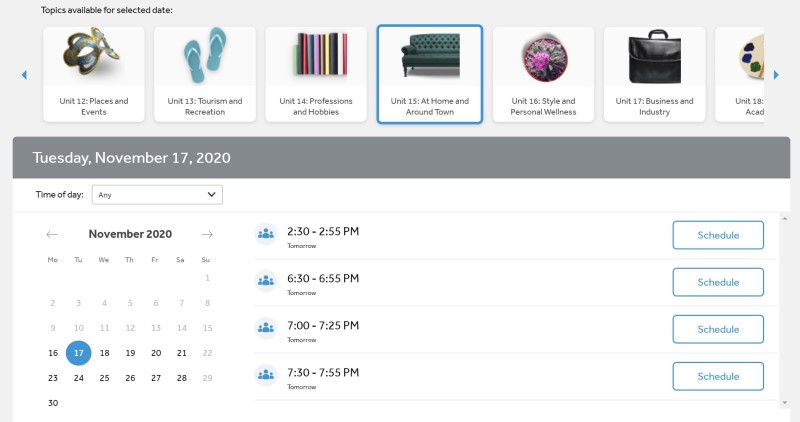
Actual use is just as easy. From the start screen, you can begin the live session and you’re already in a virtual classroom with a teacher and other language learners.
The Live Tutoring Process
Within the lesson, the topics of the corresponding lesson are revisited and explored in depth through a question-and-answer game. The coach shows various images, which you already know from the different exercises, and asks each participant questions, which they answer.
Basically, it’s really like being in a language school, only you have far fewer participants “around you.” However, this also means you have to listen to the sometimes incorrect pronunciation of others. A disadvantage that language teaching inherently brings.
On the positive side, however, is the frequency with which you actively speak, as you are constantly prompted to do so, and the small group size contributes to this. And in true Rosetta Stone style, they don’t dwell long on grammatical explanations or similar things; rather, active speaking is the focus. Furthermore, I’ve been very lucky with my Spanish sessions so far, as I was always the only student. That’s 25 minutes of active exchange, which is quite intensive.
Interim Conclusion: Interesting and well implemented! If you want to learn more, you can find a separate article on the topic of the virtual classroom here.

‒ Black Friday: Language Special ‒
Saving money never hurt anyone, right?
Find the best discounts and exclusive coupons for top
language courses here!
+ + + Limited-Time Deals +++ Some Offers Expiring Soon +++ Don’t Miss Out! + + +
Target Audience – Who is Rosetta Stone Suitable For?
The honest answer to the question of who Rosetta Stone is suitable for is probably: “Anyone who can afford it!” Because unfortunately, their language courses are a few euros more expensive than competitors, so it’s worth keeping an eye out for offers and discounts here.
Want to test your own learning type? Find a scientific analysis here ->
Rosetta Stone uses a very good learning method that works intuitively with images. As a visual learner, I always had difficulties finding a suitable product for language learning, so Rosetta Stone feels like a salvation. But the entertaining exercises are also ideal for kinesthetic learners. There is also plenty to read, and all words and sentences are fully voiced. Rosetta Stone is therefore also suitable for literary and auditory language learners.
Rosetta Stone Prices and Discounts
The good news first. The previously high prices are a thing of the past. In previous years, Rosetta Stone’s pricing models varied depending on the product purchased. The no-longer-available download version had an RRP of €399. The six-month online access was available for €219, which corresponded to €36.50 per month.
These were, of course, hefty prices. Nevertheless, my conclusion at the time was: “However, I do not consider the prices to be excessive for the service provided. Keep in mind that, for example, online access also includes four lessons per month in the virtual classroom.”

‒ The Best Language Course of 2025 ‒
We’ve tested dozens of language courses…
But only ONE takes the #1 spot!
Current Rosetta Stone Prices (2025)
Rosetta Stone significantly changed its pricing policy in 2025. Currently, you can choose between two different monthly subscriptions and a lifetime subscription. For the latter, the name is very confusing, as it involves a one-time payment followed by lifelong access to all languages and courses that Rosetta Stone offers.
Important: The new prices no longer include tutoring in the virtual classroom; this can now be flexibly added in the app as desired. The Rosetta Stone prices are currently structured as follows, although, as we’ll see below, you almost never pay these full prices:
- €14,95 per month for the 3-month subscription in one language (€44,85 total)
- €10,95 per month for the 12-month subscription in one language (€131,10 total)
- €199 one-time payment for all languages for life
The lifetime offer used to be called “Rosetta Stone Unlimited,” which was a much better name: lifelong access to all languages. And for anyone planning to learn multiple languages, or perhaps share access with children and a spouse, this is a very good deal. It’s important to remember that this is a one-time payment, with the known advantages over subscriptions.
To put the prices listed above into perspective, we’ve included another screenshot of the prices, which shows that there are currently very decent discounts available. And these are often available, but not always. Especially the “Lifetime Subscription” was not always available in the past. This means the “All Languages for Life” offer is time-limited and it’s possible this promotion could end at any time and not reappear! You can check this here:
However, for those leaning towards a classic subscription, we also have very good news. We have defined our links to Rosetta Stone so that you are always directed to the page with the currently largest possible discounts. And admittedly, the courses are usually always available at a discount. Just click through, it’s worth it!
In my opinion, you should definitely try Rosetta Stone. And this is now easier than ever. Rosetta Stone currently offers the opportunity to test the entire program for three days. In addition, there is a very long money-back guarantee of 30 days. If you still want to cancel your Rosetta Stone subscription, you can find more info here.
Is It Worth the Money?
This question is probably best answered by looking at the competition. So you don’t have to scour the entire internet for individual language courses, we’ve created a handy overview. Here you’ll find the best and most sought-after language courses in a price comparison – at a glance. We’ll also give you some tips on how to get the most for your money.
Speaking of saving: language learning doesn’t have to be expensive. Click here for the best vouchers and discounts, so you can start your language adventure affordably. It pays to be quick. Besides the great Rosetta Stone alternatives you’ll read about shortly, other providers with innovative concepts are also included. Definitely check it out!
Alternatives to Rosetta Stone
Are there alternatives to Rosetta Stone? Many of them, however, offer fewer features. But that’s not always the case, as our first recommendation shows.
Babbel: The People’s Language Course Now Also with Live Lessons
We like to call Babbel the people’s language course because they offer a great and comprehensive learning experience for an affordable price. Unlike Rosetta Stone, Babbel relies more on the classic learning approach, so you’ll also find grammar explanations here.
Brand new, Babbel now also offers the option to book language lessons in a virtual classroom. The scope here is therefore quite comparable to Rosetta Stone.
Mosalingua: More Than Just Vocabulary
If you feel like Babbel doesn’t offer enough freedom within the course, you might want to try Mosalingua. They have some different languages and combine all features of a classic flash-card style vocabulary trainer with well-thought out bonus content, making it quite a premium solution. Its easy to tailor to your exact needs.
Mosalingua is also moving with the current times, as they have recently integrated a clever chatbot-feature with a way broader range than Babbels as you can freely choose your topic. You can also use the basic app for free! However, to unlock all features that make Mosalingua stand out to us, we still recommend their subscriptions. No worries, there’s a free trial period!
Mondly: The Motivation Artist at an Affordable Price
In terms of motivation, Rosetta Stone is unfortunately not very strong. Here, success comes to those who can motivate themselves. If you have problems with exactly that, then Mondly is recommended. They impress with such great motivation features that they secured the top spot in the “Motivation” category in our review.
Furthermore, Mondly also offers an option for a one-time payment and lifelong access! This not only secures you 41 languages, learning in virtual reality, and free access to the Mondly KIDS app, but you also save about 50-60% compared to the comparable Rosetta Stone offer.
talkREAL Tip! In our comprehensive Rosetta Stone Guide, you’ll also find many direct comparisons between Rosetta Stone and other language courses. Read now!
Conclusion: Rosetta Stone Review
– Thanks to the Dynamic Immersion Method, Rosetta Stone is Different and Better –
In my opinion, Rosetta Stone is one of the best language courses on the market – period! Although even this conclusion doesn’t do Rosetta Stone justice. Because it’s much more than just an (online) language course. It’s an entire learning environment, including teachers in a virtual classroom, and short stories to read and listen to. However, the various learning games and the great online community have been discontinued, which is a negative point for us. But since the prices have also dropped, this is acceptable.
The learning method offered is absolutely brain-friendly, and you learn the foreign language very intuitively. The comparison to learning one’s native language is therefore not just a marketing gimmick, but a reality. Many weeks of intensive use have convinced me accordingly. This applies in particular to the online course with its extended learning content, the lessons in the virtual classroom, and the very good mobile apps.
The only real catch is and remains the slightly higher price. After the detailed review, however, I can understand this. The quality, especially in the visual implementation of the Dynamic Immersion method, is the best currently available on the market, in my view. And quality, as is known, has its price.
I can recommend Rosetta Stone to all language learners. Check it out. Thanks to the 30-day money-back guarantee, you are also on the safe side.
Rosetta Stone does many things differently. And above all, it does many things much better than comparable language offerings. However, you also have to let go of traditional learning beliefs, which is not always easy. But anyone who fully engages with the Dynamic Immersion method will achieve very good results with Rosetta Stone!
Didactics:
8.5 / 10
Usability:
9 / 10
Value for Money:
8.5 / 10
Overall Rating: 8.7 / 10
